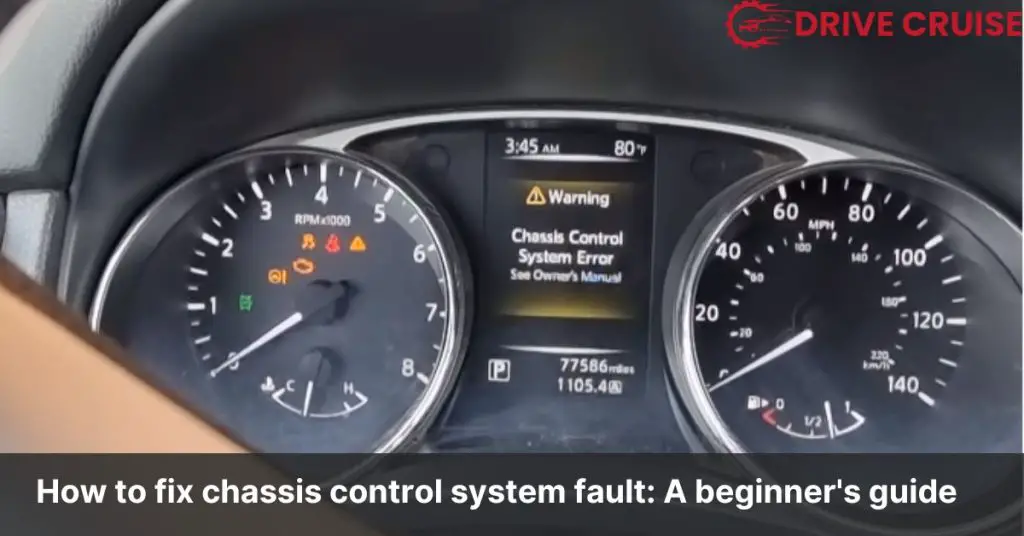Encountering a “Chassis Control System Fault” message on your vehicle’s dashboard can be unnerving. This warning signifies a malfunction within the electronic systems responsible for maintaining vehicle stability and handling. While it might be tempting to attempt a DIY fix, the chassis control system is complex. This guide equips drivers and automotive technicians with a roadmap for troubleshooting the issue and navigating potential repair solutions.
The chassis control system is a new technology specific to some vehicles, such as Nissan. It includes active trace control, active engine braking, and active ride control. The chassis control system gets data from sensors such as wheel speed sensors. It also receives information such as yaw rate, g-forces, and driving forces from steering, acceleration, and braking inputs. In short, the chassis control system is responsible for keeping your vehicle stable and safe on the road.
If you encounter a “Chassis Control System Fault” message, it could be due to a variety of reasons, such as a malfunctioning sensor or a wiring issue. It is important to understand the potential causes and solutions before attempting any repairs. In the following sections, we will explore common causes of a chassis control system fault and provide step-by-step instructions for fixing the issue.
Importance of the Chassis Control System
The Chassis Control System is a crucial component of modern-day vehicles. It integrates various electronic systems such as ABS, traction control, electronic stability control, and others to enhance vehicle stability and control during maneuvers or slippery conditions. The system utilizes a network of sensors to monitor wheel speed, steering angle, and other parameters to adjust braking and engine power to maintain vehicle control.
The Control Chassis system is responsible for ensuring that your vehicle stays stable and safe on the road. It helps prevent accidents by ensuring that you have maximum control over your car at all times. The Chassis Control System also helps to improve the handling of your vehicle, making it easier and more comfortable to drive.
If you experience any Chassis System Control Error, it is essential to address it promptly. Ignoring the issue can lead to further damage to your vehicle and put you and your passengers at risk. The Chassis Control System Error can be caused by various issues, such as faulty sensors, loose connections, and worn-out components.
Regular maintenance of your vehicle is crucial to avoid Chassis Control System Error. It includes changing the oil regularly, checking the fluid levels, inspecting the brakes, and aligning the wheels regularly. Tire inspection is also critical, as they play a crucial role in Chassis Control.
Understanding Why You See ‘Chassis Control System Fault’
If you own a Nissan or Infiniti, you may have seen the warning light “Chassis Control System Fault” appear on your dashboard. This warning can be concerning, but it doesn’t necessarily mean there’s a major problem with your vehicle. The complexity of the system means various issues can trigger the warning, categorized by:
Sensor Faults
Wheel Speed Sensor Malfunction:
One of the most common reasons for the warning light is a malfunctioning wheel speed sensor. This sensor provides data about wheel rotation to the chassis control system. If the sensor is faulty, it can disrupt the system’s functionality, leading to the warning light. Symptoms might include uneven braking or inoperative ABS.
Steering Wheel Position Sensor Issues:
Another sensor that can cause problems is the steering wheel position sensor. This sensor detects the position of the steering wheel and sends that information to the chassis control system. If the sensor is malfunctioning, it can disrupt the system’s understanding of driver input, affecting stability control.
System Malfunctions
Control Module Failure:
The control module is the brain of the system, processing sensor data and issuing commands. Internal hardware issues can lead to system errors. If the control module fails, it can trigger the warning light.
Software Bugs:
Temporary glitches in the system software can disrupt communication or lead to misinterpretations of sensor data. This can lead to false alarms or other system errors.
Other Potential Causes
Low Battery Voltage:
In rare instances, insufficient battery voltage can affect the functionality of electronic systems like chassis control. If the battery is low or failing, it may not provide enough power to the chassis control system.
Damaged Wiring or Connectors:
Worn, frayed, or corroded wiring or loose connections can disrupt communication within the system. This can lead to false alarms or other system errors.
What to Do When You See ‘Chassis Control System Fault’
If you see the “Chassis Control System Fault” message on your Nissan Qashqai, it means that there is an issue with the vehicle’s chassis control system. Here are some steps to take when you encounter this problem:
Safety First
First and foremost, ensure your safety and that of other road users. Although the system might be disabled, you should still be able to steer and brake the vehicle, albeit with less electronic assistance. However, it is still important to remain vigilant and cautious while driving.
Reduce Speed
Drive cautiously and at reduced speeds until the issue is addressed. This will help to minimize the risk of further damage or accidents while you work on fixing the problem.
Warning Lights
Note any additional warning lights accompanying the “Chassis Control System Error” message. These can provide further clues to the problem. For instance, if the battery warning light is also on, it could indicate that the issue is with the battery or charging system.
Once you have taken these initial steps, you can proceed to diagnose and fix the problem. However, it is important to note that chassis control system faults can be complex and require expert assistance. Therefore, it is recommended that you seek professional help to fix the issue.
In some cases, the fault may be due to a failing battery or insufficient use to fully charge it. Therefore, you should also check the battery and charging system to ensure they are working correctly. If the battery is old, it may need to be replaced with a new one.
Why DIY Fixes Are Not Recommended
If you’re experiencing a chassis control system fault in your Nissan Rogue, you may be tempted to try and fix it yourself. However, there are several reasons why DIY fixes are not recommended.
Diagnostic Complexity
Identifying the exact cause of the fault requires specialized tools and expertise to analyze sensor data, check system functionality, and pinpoint electrical issues. Without these tools and knowledge, it can be difficult to accurately diagnose the problem. Attempting to fix the issue without properly identifying the root cause can lead to further damage and potentially compromise the safety of your vehicle.
Risk of Further Damage
Improper troubleshooting or repairs can worsen the problem and potentially compromise vehicle safety. The chassis control system is a complex and interconnected system that requires careful attention to detail and expertise to repair. Attempting to fix the issue without proper knowledge and tools can lead to further damage and potentially put you and your passengers at risk.
The Importance of Professional Repair
When it comes to fixing a chassis control system fault, it’s important to trust qualified technicians to handle the job. These professionals possess the knowledge and tools necessary to diagnose the fault accurately and perform the necessary repairs.
Qualified Technicians
Qualified technicians are trained to identify the root cause of the fault, whether it be a faulty sensor, electrical problem, or software issue. They use specialized equipment to diagnose the fault and ensure that it is repaired correctly the first time.
Repair Solutions
Depending on the cause of the fault, repair solutions may involve replacing faulty sensors, updating software, or repairing electrical problems. In rare cases, a complete control module replacement might be necessary.
It’s important to note that attempting to fix a chassis control system fault on your own can be dangerous and may lead to further damage. Therefore, it is recommended that you leave the repairs to the professionals.
Whether you’re dealing with a Nissan Rogue chassis control system error from 2015, 2017, or 2019, a qualified technician will be able to diagnose and repair the issue in a safe and effective manner. Trusting a professional to handle the job will give you peace of mind and ensure that your vehicle is operating safely and efficiently.
Preventing Future Issues
To avoid future issues with your car’s chassis control system, it’s important to take preventative measures. Here are a few things you can do to keep your car running smoothly:
Regular Maintenance
Regular maintenance checks are essential for keeping your car in good condition. During these checks, your mechanic will inspect the various components of your chassis control system, including the electrical connections. By catching any issues early on, you can prevent them from turning into bigger problems down the road.
Software Updates
It’s important to check for and install any recommended software updates from your car manufacturer. These updates can optimize the performance of your chassis control system and prevent any potential errors. Be sure to check with your manufacturer regularly to ensure that you have the most up-to-date software.
Addressing Warning Signs
If you notice any unusual noises or vibrations in your car’s braking or steering system, don’t ignore them. These warning signs could be an indication of a larger issue with your chassis control system. Early detection can prevent further problems and save you money in the long run.
Conclusion
In conclusion, a chassis control system fault can be a serious issue that affects your vehicle’s performance and safety on the road. It is important to take the necessary steps to diagnose and fix the problem promptly.
If you are experiencing a chassis control system fault, there are some basic troubleshooting steps you can take, such as checking the battery connection, inspecting the tires, and replacing faulty sensors. However, it is important to keep in mind that these steps may not always be enough to resolve the issue.
Understanding the complexities behind chassis control system faults emphasizes the importance of seeking professional help. A qualified technician can diagnose the issue accurately and implement the proper repairs to ensure the optimal performance of your vehicle’s chassis control system and your safety on the road.
It is important to prioritize consulting a professional to avoid potentially causing further damage. Attempting to fix the issue yourself without proper knowledge and expertise can lead to more serious problems down the line.
Related Posts:
- Can You Drive a Right Hand Drive Car in the US? Everything You Need to Know
- Car Overheating: Causes and Solutions for Normalization
- Chassis Control System Error: Causes and Solutions
- Ford Focus: Years to Avoid for a Smoother Ride
- How to fix chassis control system fault: A beginner’s guide
- How to Fix Tire Cupping: Tips and Tricks for a Smoother Ride
- Lexus RX 400h Problems: What You Need to Know
- Nissan Forward Emergency Braking Warning Light Reset: A Quick Guide
- Nissan Qashqai Malfunction Warning Light: What You Need to Know
- Toyota Corolla Gear: A Guide to Understanding Your Car’s Transmission
- Yokohama Geolandar AT G015 Review: A Reliable All-Terrain Tire









